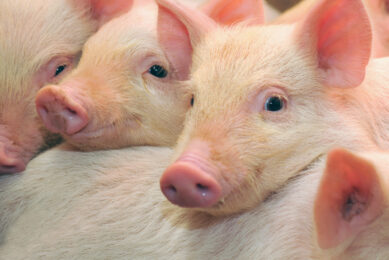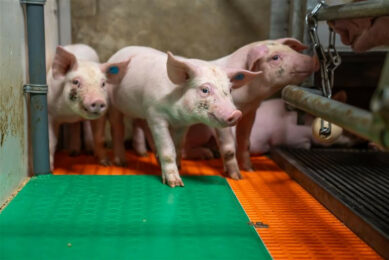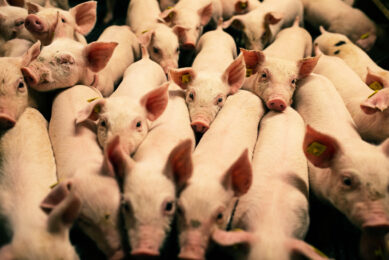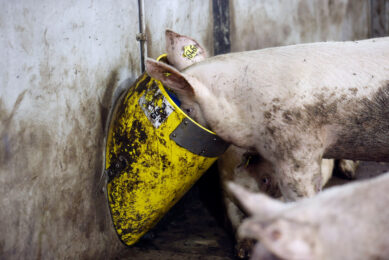Making Weaners Eat
Not an easy task, sometimes even impossible. Pigs weaned without substantial pre-weaning feeding experience are almost invariably suffering from depressed feed intake post-weaning. And, this is a problem. The less weaned pigs eat the first week post-weaning, the less efficient they are throughout the growing finishing period. Plus, or rather minus (!), their health is in great danger during this transition period when stomachs remain empty. So, what can be done? Here’s a short list that may be of some help. Not all recommendations work simultaneously in all farms, but at least one of them should be working in most cases.
Not an easy task, sometimes even impossible.
Pigs weaned without substantial pre-weaning feeding experience are almost invariably suffering from depressed feed intake post-weaning. And, this is a problem. The less weaned pigs eat the first week post-weaning, the less efficient they are throughout the growing finishing period. Plus, or rather minus (!), their health is in great danger during this transition period when stomachs remain empty. So, what can be done?
Here’s a short list that may be of some help. Not all recommendations work simultaneously in all farms, but at least one of them should be working in most cases.
Health
This cannot be overemphasised enough. Sick pigs, even subliminally affected by some pathogen, never eat enough. Improving overall health status always improves feed intake and growth performance.
This cannot be overemphasised enough. Sick pigs, even subliminally affected by some pathogen, never eat enough. Improving overall health status always improves feed intake and growth performance.
Management
With (proper) management we create an environment suitable for maximal performance. Without this framework, growth and feed intake are always impaired. Farm employees should be considered as your best assets and be constantly trained and encouraged to look after weaned pigs with care.
With (proper) management we create an environment suitable for maximal performance. Without this framework, growth and feed intake are always impaired. Farm employees should be considered as your best assets and be constantly trained and encouraged to look after weaned pigs with care.
Temperature
Pigs that are too warm and comfortable may not venture out to seek food. Pigs that are hot always reduce their feed intake to avoid internal heat production from metabolism. Best results are obtained when pigs are kept at a temperature not higher than their lower critical temperature zone. This applies to the whole room, as hot spots should always be provided during the immediate post-weaning period.
Pigs that are too warm and comfortable may not venture out to seek food. Pigs that are hot always reduce their feed intake to avoid internal heat production from metabolism. Best results are obtained when pigs are kept at a temperature not higher than their lower critical temperature zone. This applies to the whole room, as hot spots should always be provided during the immediate post-weaning period.
Lighting
Providing continuous lighting during the first couple days post-weaning reduces the time pigs take to start consuming feed. In the dark, weaned pigs prefer to remain in the safety of their group instead of venturing out for feed. Past the first few first days, normal lighting schemes should be initiated.
Providing continuous lighting during the first couple days post-weaning reduces the time pigs take to start consuming feed. In the dark, weaned pigs prefer to remain in the safety of their group instead of venturing out for feed. Past the first few first days, normal lighting schemes should be initiated.
Diet digestibility
Feed intake is linearly associated with nutrient digestibility. Nursery diets fortified with cooked cereals, milk proteins, fish meal, and simple sugars such as lactose and sucrose, are readily consumed by young pigs. In contrast, ingredients of poor digestibility promote bacterial proliferation in the hind gut often leading to scours. It pays off to use high quality diets!
Feed intake is linearly associated with nutrient digestibility. Nursery diets fortified with cooked cereals, milk proteins, fish meal, and simple sugars such as lactose and sucrose, are readily consumed by young pigs. In contrast, ingredients of poor digestibility promote bacterial proliferation in the hind gut often leading to scours. It pays off to use high quality diets!
Additives
Certain additives, such as antimicrobial agents, zinc oxide, copper sulfate, organic acids, and plasma protein, improve post-weaning growth performance and feed intake. An improvement of 10 to 50% in performance can be easily realised when the proper combination of such ingredients is used, but the response is more pronounced when health, facilities, and management are sub-optimal.
Certain additives, such as antimicrobial agents, zinc oxide, copper sulfate, organic acids, and plasma protein, improve post-weaning growth performance and feed intake. An improvement of 10 to 50% in performance can be easily realised when the proper combination of such ingredients is used, but the response is more pronounced when health, facilities, and management are sub-optimal.
Mat-feeding
Post-weaning feed intake may be dramatically enhanced by spreading a small quantity of feed on floor-mats or on solid floors. This greatly encourages pigs to express their natural rooting behavior and ingest solid feed as early as the first day post-weaning. A mash provides equal results to pellets, but with pellets wastage is often higher. Placing the mat near the feeder seems to encourage pigs to consume more feed from the feeder.
Post-weaning feed intake may be dramatically enhanced by spreading a small quantity of feed on floor-mats or on solid floors. This greatly encourages pigs to express their natural rooting behavior and ingest solid feed as early as the first day post-weaning. A mash provides equal results to pellets, but with pellets wastage is often higher. Placing the mat near the feeder seems to encourage pigs to consume more feed from the feeder.
Gruel feeding
A gruel (50:50) of feed and water or liquid milk replacer offered to fallback and light pigs in bowl feeders during the first 2 to 3 days post-weaning can markedly improve the health and performance of these animals. This practice prevents starvation and more importantly, dehydration. Unless the gruel is gradually thickened (70:30), piglets may fail to adapt to dry feed. This technique is best combined with mat-feeding.
A gruel (50:50) of feed and water or liquid milk replacer offered to fallback and light pigs in bowl feeders during the first 2 to 3 days post-weaning can markedly improve the health and performance of these animals. This practice prevents starvation and more importantly, dehydration. Unless the gruel is gradually thickened (70:30), piglets may fail to adapt to dry feed. This technique is best combined with mat-feeding.











